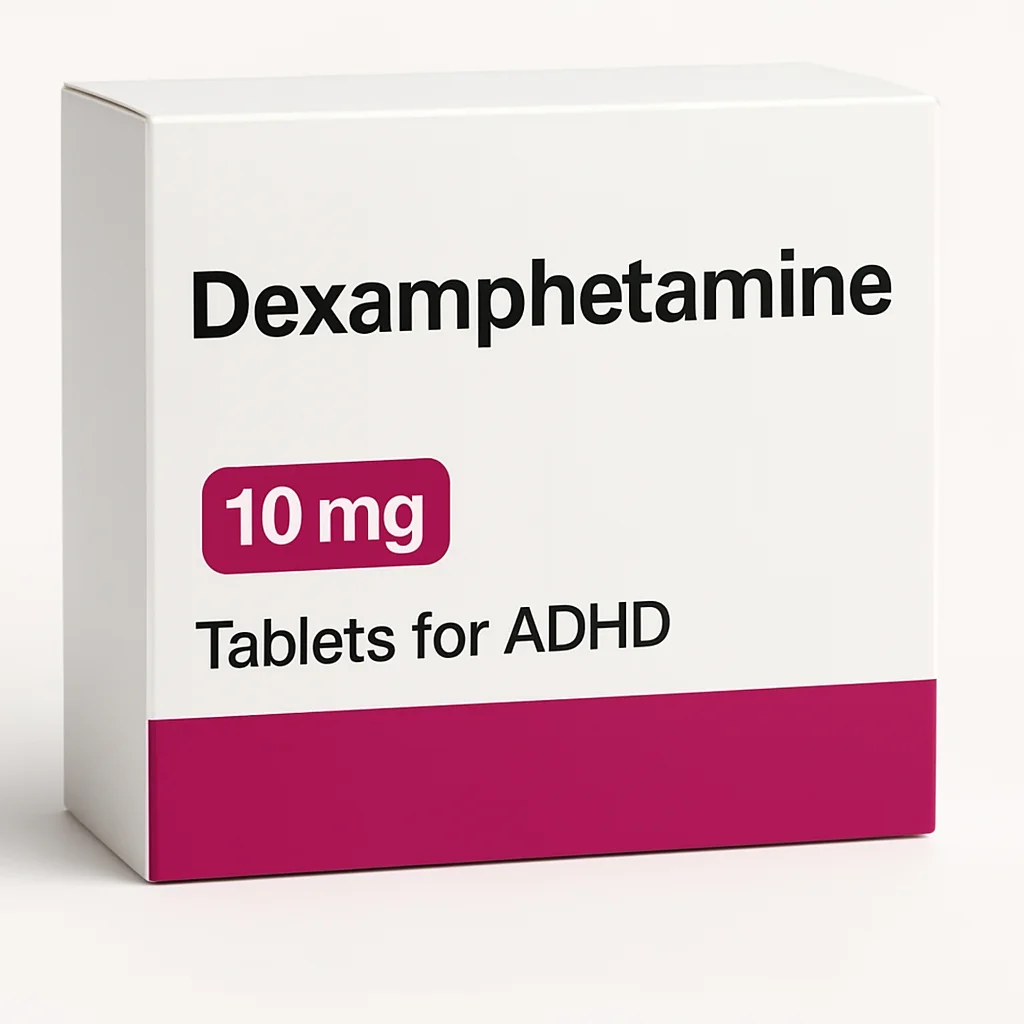Free UK shipping
Results in under 14 days
UK lab
10% Off All Tests - Autumn 2025
Introduction to Dexamfetamine
Attention Deficit Hyperactivity Disorder (ADHD) remains one of the most studied neurodevelopmental conditions—and our understanding of it continues to evolve. ADHD has a strong hereditary component, with studies showing 60–90% genetic influence (6). Brain-imaging research suggests differences in how several regions—especially the prefrontal cortex, which regulates attention, reward, and impulse control—communicate using the neurotransmitters dopamine and noradrenaline (6).
Dexamfetamine (d-amphetamine) is the active isomer of amphetamine. Despite its history of misuse during wartime and on the black market, it remains an important, regulated treatment for ADHD (17, 18). It increases dopamine and noradrenaline activity by blocking their reuptake, stimulating their release from storage vesicles, and inhibiting monoamine oxidase (MAO) (17, 2). These combined effects help improve concentration and behavioural control, while reducing hyperactivity (2, 6, 11).
In the UK, dexamfetamine is a Schedule 2 Controlled Drug, meaning prescribing and dispensing are tightly regulated.

Considerations for Patients Taking Dexamfetamine
Clinical studies show that both dexamfetamine and its longer-acting prodrug, lisdexamfetamine, are broadly comparable in effectiveness to methylphenidate for treating ADHD. However, individuals respond differently—around 10% of patients show limited benefit from either stimulant class (16). Some research suggests slightly greater overall efficacy for amphetamine-based stimulants compared with methylphenidate (17).
Abuse Potential
The potential for abuse among ADHD patients prescribed dexamfetamine is very low (17).
This is because:
-
Individuals with ADHD typically begin with lower dopamine activity in the brain’s reward centres.
-
Therapeutic dosing uses oral tablets, not rapid-delivery routes such as smoking or injection.
-
Blood levels rise slowly, avoiding the sharp peaks linked to addiction. In fact, many ADHD patients find taking their medication consistently each day more challenging than stopping misuse (17).
Cardiovascular Risk
Both dexamfetamine and lisdexamfetamine can raise blood pressure and heart rate by stimulating the adrenergic “fight-or-flight” system (2). Typical effects include mild tachycardia, arrhythmia, or hypertension, which usually resolve when treatment is stabilised. Blood pressure and heart function should be monitored throughout therapy (4). Use is contraindicated in individuals with heart abnormalities (18).
Psychiatric Considerations
Dexamfetamine influences the amygdala, a brain region that processes anxiety and emotional reactivity (6). Although it helps many people feel calmer and more focused, it can occasionally trigger anxiety, irritability, or mood swings. Pharmacovigilance data also report rare cases of psychosis, aggression, or hostility, particularly in vulnerable individuals (6). For patients with a history of psychiatric illness or depression, dexamfetamine should be prescribed cautiously and monitored closely (18).
Explore PGX for Mental HealthWhy Have I Been Prescribed Dexamfetamine?
Treating ADHD
Dexamfetamine is used to treat ADHD and, in some cases, narcolepsy (12). Because it is a controlled medicine, treatment must be initiated and reviewed by a specialist (12).
Dexamfetamine Doses
How and when to take it
ADHD (Adults)
-
Start with 5 mg twice daily
-
Increase gradually each week based on response
-
Usual maximum: 60 mg per day, taken in divided doses
ADHD (Children 6–17 years)
-
Start with 2.5 mg two to three times daily
-
Increase by 5 mg each week if required
-
Usual maximum: 1 mg per kg of body weight per day (up to 20–40 mg)
Narcolepsy (Adults)
-
Start with 10 mg daily in divided doses
-
Increase gradually if necessary
-
Maximum: 60 mg per day
Always take dexamfetamine in the morning or early afternoon to avoid sleep disturbance.
Dexamfetamine Side Effects
Dexamfetamine’s side effects are usually related to its stimulant effect on the brain and body.
Most Common Side Effects (18):
-
Difficulty sleeping (insomnia)
-
Loss of appetite or weight loss
-
Headache
-
Dry mouth
-
Nausea or stomach discomfort
-
Feeling nervous or restless
Less Common Side Effects:
-
Elevated heart rate or blood pressure
-
Dizziness or fainting
-
Mood changes or irritability
-
Rarely, hallucinations or aggression
If side effects are troublesome or persistent, your prescriber may adjust your dose or suggest an alternative medication.
Explore PGX for Mental HealthHow Your Body and Genes Process Dexamfetamine
Dexamfetamine and lisdexamfetamine share similar pharmacology, but lisdexamfetamine acts as a prodrug that is slowly converted into dexamfetamine in red blood cells (18, 20). Once active dexamfetamine is released into circulation, it is distributed widely, including to the brain.
 Metabolism
Metabolism
Dexamfetamine is metabolised primarily through two routes:
-
Aromatic hydroxylation via CYP2D6, forming the active metabolite 4-hydroxyamphetamine.
-
Oxidative deamination, producing inactive metabolites such as phenylacetone.
People with reduced CYP2D6 activity (poor metabolisers) have higher drug concentrations, which can increase both clinical response and the likelihood of side effects (21).
 Elimination
Elimination
The medicine and its metabolites are removed through the urine. This process is faster when urine is acidic and slower when it’s more alkaline (for example, after eating large amounts of dairy or taking antacids).
Personalising Dexamfetamine with Pharmacogenetics
Currently, CYP2D6 is the main gene known to affect how dexamfetamine is processed. Patients who are poor metabolisers may require a lower dose or closer monitoring (21). Pharmacogenomic testing can provide early insight, helping your clinician tailor the starting dose and anticipate side-effect risk. Because dexamfetamine affects both cardiovascular and emotional regulation, understanding your genetic profile allows safer, more personalised prescribing.
Related Medications:
Other ADHD treatments with similar goals include:
-
Lisdexamfetamine (Elvanse) – a longer-acting prodrug that releases dexamfetamine gradually
-
Methylphenidate (Ritalin, Concerta) – a shorter-acting stimulant
-
Atomoxetine (Strattera) – a non-stimulant option targeting noradrenaline
-
Viloxazine (Qelbree) – a newer non-stimulant medicine
References
(1) NCBI Bookshelf: Amphetamine Overview; (2) PMC8063758; (3) SpringerLink: 10.1007/s43440-025-00763-0; (4) Frontiers in Pharmacology: 10.3389/fphar.2023.1208456; (5) PMC10876479; (6) SpringerLink: 10.1007/s40120-022-00392-2; (7) ScienceDirect: S0165178125002069; (8) MDPI Pharmaceuticals 5(2):9; (9) Nature Translational Psychiatry: s41398-023-02729-3; (10) PMC10564936; (11) PMC5167011; (12) British National Formulary (BNF); (13) PMC7039663; (14) PMC5789875; (15) PMC4857871; (16) PMC2515906; (17) PMC3666194; (18) Wiley: 10.1002/hup.2910; (19) NCBI Bookshelf: NBK507808; (20) PMC5594082; (21) Pharmacogenetics: CYP2D6 Genetic Variation Study (2024).